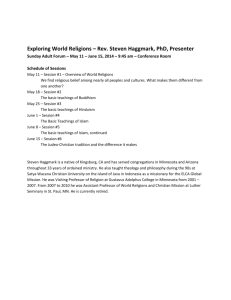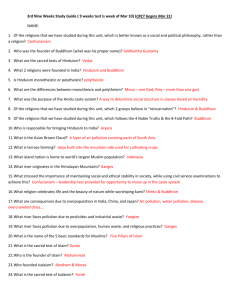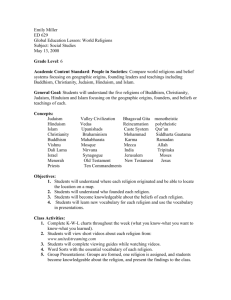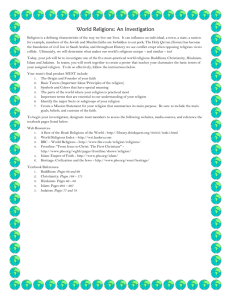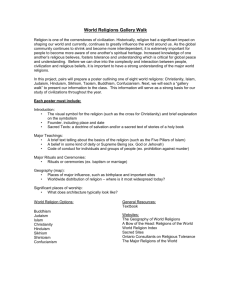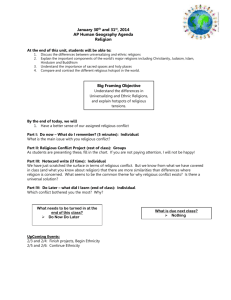Religions and Ethical Systems
advertisement
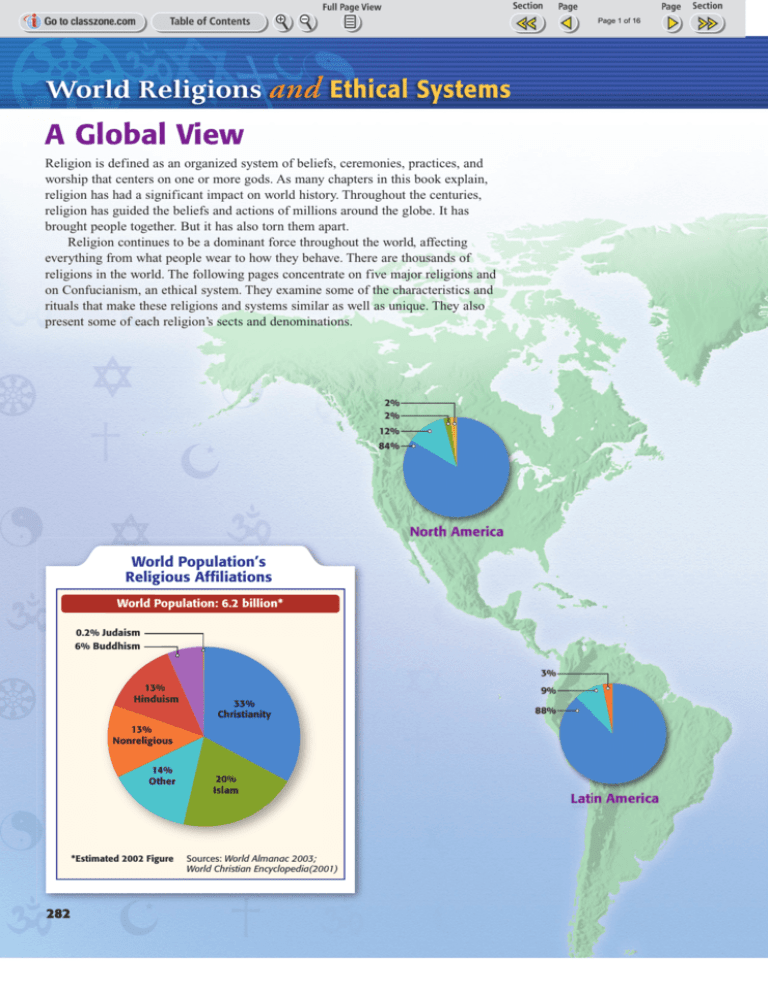
Page 1 of 16 A Global View Religion is defined as an organized system of beliefs, ceremonies, practices, and worship that centers on one or more gods. As many chapters in this book explain, religion has had a significant impact on world history. Throughout the centuries, religion has guided the beliefs and actions of millions around the globe. It has brought people together. But it has also torn them apart. Religion continues to be a dominant force throughout the world, affecting everything from what people wear to how they behave. There are thousands of religions in the world. The following pages concentrate on five major religions and on Confucianism, an ethical system. They examine some of the characteristics and rituals that make these religions and systems similar as well as unique. They also present some of each religion’s sects and denominations. World Population’s Religious Affiliations World Population: 6.2 billion* 0.2% Judaism 6% Buddhism 13% Hinduism 33% Christianity 13% Nonreligious 14% Other *Estimated 2002 Figure 282 20% Islam Sources: World Almanac 2003; World Christian Encyclopedia(2001) Page 2 of 16 Religious Affiliations ■ Christian ■ Muslim ■ Hindu ■ Buddhist ■ Jewish ■ Other ■ Nonreligious *Communist China is officially atheist (disbelieving in the existence of God). Unofficially, the Chinese practice a number of religions and ethical systems, including Daoism, Confucianism, and a variety of folk religions. World Religions and Ethical Systems 283 Page 3 of 16 Buddhism Ritual ▲ Buddhism has influenced Asian religion, society, and culture for over 2,500 years. Today, most Buddhists live in Sri Lanka, East and Southeast Asia, and Japan. Buddhism consists of several different sects. A religious sect is a group within a religion that distinguishes itself by one or more unique beliefs. Buddhists are united in their belief in the Buddha’s teachings, known as the dharma. Because the Buddha is said to have “set in motion the wheel of the dharma” during his first sermon, his teaching is often symbolized by a wheel, as shown above. The Buddha taught that the key to happiness was detachment from all worldly goods and desires. This was achieved by following the Noble Eightfold Path, or the Middle Way, a life between earthly desires and extreme forms of self-denial. Women in Rangoon, Myanmar, sweep the ground so that monks can avoid stepping on and killing any insects. Many Buddhists believe in rebirth, the idea that living beings, after death, are reborn and continue to exist. Buddhists believe that all living beings possess the potential for spiritual growth—and the possibility of rebirth as humans. RESEARCH LINKS For more on Buddhism, go to classzone.com ▼ Leadership Those who dedicate their entire life to the teachings of the Buddha are known as Buddhist monks and nuns. In many Buddhist sects, monks are expected to lead a life of poverty, meditation, and study. Here, Buddhist monks file past shrines in Thailand. To learn humility, monks must beg for food and money. ▲ Worship Practices Statues of the Buddha, such as this one in China, appear in shrines throughout Asia. Buddhists strive to follow the Buddha’s teachings through meditation, a form of religious contemplation. They also make offerings at shrines, temples, and monasteries. 284 Page 4 of 16 Learn More About Buddhism Major Buddhist Sects Mahayana Theravada Buddhism Mantrayana The Three Cardinal Faults This image depicts what Buddhists consider the three cardinal faults of humanity: greed (the pig); hatred (the snake); and delusion (the rooster). Dhammapada One of the most well-known Buddhist scriptures is the Dhammapada, or Verses of Righteousness. The book is a collection of sayings on Buddhist practices. In this verse, Buddhists are instructed to avoid envying others: Let him not despise what he has received, nor should he live envying the gains of others. The disciple who envies the gains of others does not attain concentration. Dhammapada 365 Chapter Connection For a more in-depth examination of Buddhism, see pages 68–71 of Chapter 3, and page 193 of Chapter 7. World Religions and Ethical Systems 285 Page 5 of 16 Christianity Christianity is the largest religion in the world, with about 2 billion followers. It is based on the life and teachings of Jesus Christ. Most Christians are members of one of three major groups: Roman Catholic, Protestant, or Eastern Orthodox. Christianity teaches the existence of only one God. Christians regard Jesus as the son of God. They believe that Jesus entered the world and died to save humanity from sin. The cross shown above, a symbol of the crucifixion of Jesus Christ, represents Jesus’ love for humanity by dying for its sins. Christians believe that they reach salvation by following the teachings of Jesus Christ. RESEARCH LINKS For more on Christianity, go to classzone.com ▲ Ritual Each year, hundreds of thousands of Christians from all over the world visit the Basilica of Guadalupe in northern Mexico City. The church is considered the holiest in Mexico. It is near the site where the Virgin Mary, the mother of Jesus Christ, is said to have appeared twice in 1531. Out of deep respect for Mary, some pilgrims approach the holy cathedral on their knees. ▲ Worship Practices Worshiping as a group is an important part of Christian life. Most Protestant services include praying, singing, and a sermon. Some services include baptism and communion, in which bread and wine are consumed in remembrance of Jesus’ death. Communion celebrates the last meal Jesus took with his disciples, as illustrated here in the Last Supper by Leonardo da Vinci. 286 Page 6 of 16 Learn More About Christianity Major Christian Sects Eastern Orthodox Roman Catholic Christianity AME** Protestant* Lutheran Baptist Methodist Pentecostal Episcopal Mormon Church of God Presbyterian *In the United States alone, there are 30 Protestant denominations with over 400,000 members in each. **African Methodist Episcopal Fish Symbol ▲ Leadership In some Christian churches, the person who performs services in the local church is known as a priest. Shown here is a priest of the Ethiopian Orthodox Church. These priests, like the ministers and clergy in other Christian sects, conduct worship services and preside over marriages and funerals. Monks and nuns also provide leadership and guidance in the Christian church. The fish is an early symbol of Christianity. There are many theories about the origin of the symbol, but some Christians believe that it derives from the fact that Jesus called his disciples, or followers, “fishers of men.” The Bible The Bible is the most sacred book of the Christian religion. It is divided into two major parts: the Old Testament, which focuses on Jewish history, and the New Testament, which describes the teachings of Jesus Christ. The following verse from the New Testament reveals the fundamental teaching of Jesus: “Men, what must I do to be saved?” And they said, “Believe in the Lord Jesus, and you will be saved, you and your household.” Acts 16:30–31 Chapter Connection For more about Christianity, see pages 166–170 of Chapter 6. To learn about the Protestant and Catholic Reformations, see sections 3 and 4 of Chapter 17. World Religions and Ethical Systems 287 Page 7 of 16 Hinduism Hinduism, one of the world’s oldest surviving religions, is the major religion of India. It also has followers in Indonesia, as well as in parts of Africa, Europe, and the Western Hemisphere. Hinduism is a collection of religious beliefs that developed over thousands of years. Hindus worship several gods, which represent different forms of Brahman. Brahman is the most divine spirit in the Hindu religion. Hinduism, like Buddhism, stresses that persons reach true enlightenment and happiness only after they free themselves from their earthly desires. Followers of Hinduism achieve this goal through worship, the attainment of knowledge, and a lifetime of virtuous acts. The sound “Om,” or “Aum,” shown above, is the most sacred syllable for Hindus. It often is used in prayers. RESEARCH LINKS For more on Hinduism, go to classzone.com ▼ Ritual Each year, thousands of Hindus make a pilgrimage to India’s Ganges River. The Ganges is considered a sacred site in the Hindu religion. Most Hindus come to bathe in the water, an act they believe will cleanse and purify them. The sick and disabled come in the belief that the holy water might cure their ailments. 288 Page 8 of 16 Learn More About Hinduism Major Hindu Sects Shaktism Reform Hinduism Hinduism Vaishnavites Shaivites Three Main Gods ▲ Leadership Gurus, or spiritual teachers, play a major role in spreading Hindu beliefs. These holy men are believed to have had the gods’ words revealed to them. Brahmin priests, like the one shown here, are also religious leaders. They take care of the divine images in the temples and read from the sacred books. This statue represents Brahma, creator of the universe. Brahma, Vishnu, and Shiva are the three main gods of Hinduism. Vishnu is the preserver of the universe, while Shiva is its destroyer. Rig Veda The Vedas are the oldest Hindu scriptures—and they are older than the sacred writings of any other major religion. The following is a verse from the Rig Veda, the oldest of the four Vedas: He who gives liberally goes straight to the gods; on the high ridge of heaven he stands exalted. ▲ Celebration Each spring, Hindus in India celebrate the festival of Holi. Originally a harvest festival, Holi also symbolizes the triumph of good over evil. The festival recalls the story of Prince Prahlada, who faced death rather than cease worshiping Vishnu. During this joyous celebration, people dance in the streets and shower each other with colored powder and dyed water. Rig Veda 1.125.5 Chapter Connection For a closer look at the origins and beliefs of Hinduism, see pages 66–67 of Chapter 3, and pages 193–194 of Chapter 7. World Religions and Ethical Systems 289 Page 9 of 16 Islam Islam is a religion based on the teachings of the prophet Muhammad. Followers of Islam, known as Muslims, believe that God revealed these teachings to Muhammad through the angel Gabriel. Muslims are concentrated from southwest to central Asia and parts of Africa. Islam also has many followers in Southeast Asia. Sunni Muslims believe that their leaders should follow Muhammad’s example. Shi’a Muslims believe that their leaders should be Muhammad’s descendants. Islam teaches the existence of only one God, called Allah in the Arabic language. Muslims believe in all prophets of Judaism and Christianity. They show their devotion by performing lifelong acts of worship known as the Five Pillars of Islam. These include faith, prayer, almsgiving (charity), fasting, and a pilgrimage to Mecca. The crescent moon (shown above) has become a familiar symbol for Islam. It may be related to the new moon that begins each month in the Islamic lunar calendar, which orders religious life for Muslims. The five points of the star may represent the Five Pillars of Islam. RESEARCH LINKS For more on Islam, go to classzone.com ▼ Ritual At least once in their lifetime, all Muslims who are physically and financially able go on hajj, or pilgrimage, to the holy city of Mecca in Saudi Arabia. There, pilgrims perform several rites, or acts of worship. One rite, shown here, is walking seven times around the Ka’aba—the house of worship that Muslims face in prayer. 290 Page 10 of 16 Learn More About Islam Major Islamic Sects Sunni Islam Shi’a ▲ Celebration During the sacred month known as Ramadan, Muslims fast, or abstain from food and drink, from dawn to sunset. The family shown here is ending their fast. The most important night of Ramadan is called the Night of Power. This is believed to be the night the angel Gabriel first spoke to Muhammad. Prayer Rug Muslims often pray by kneeling on a rug. The design of the rug includes a pointed or arch-shaped pattern. The rug must be placed so that the arch points toward Mecca. The Qur’an The Qur’an, the sacred book of Muslims, consists of verses grouped into 114 chapters, or suras. The book is the spiritual guide on matters of Muslim faith. It also contains teachings for Muslim daily life. In the following verse, Muslims are instructed to appreciate the world’s physical and spiritual riches: ▲ Worship Practices Five times a day Muslims throughout the world face Mecca and pray to Allah. Pictured here are Muslims praying at a mosque in Turkey. There are no priests or other clergy in Islam. However, a Muslim community leader known as the imam conducts the prayers in a mosque. Islam also has a scholar class called the ulama, which includes religious teachers. Do you not see that God has subjected to your use all things in the heavens and on earth, and has made His bounties flow to you in exceeding measure, both seen and unseen? Qur’an, sura 31:20 Chapter Connection For a closer look at Islam, including the rise and spread of Islam and Muslim culture, see Chapter 10. World Religions and Ethical Systems 291 Page 11 of 16 Judaism is the religion of the more than 14 million Jews throughout the world. Judaism was the first major religion to teach the existence of only one god. The basic laws and teachings of Judaism come from the Torah, the first five books of the Hebrew Bible. Judaism teaches that a person serves God by studying the Torah and living by its teachings. Orthodox Jews obey the Torah without question. Conservative and Reform Jews interpret the Torah to make its teachings relevant to today’s world. The Star of David (shown above), also called the Shield of David, is the universal symbol of Judaism. The emblem refers to King David, who ruled the kingdom of Israel from about 1000–962 B.C. RESEARCH LINKS For more on Judaism, go to classzone.com ▲ Worship Practices The synagogue is the Jewish house of worship and the center of Jewish community life. Services in the synagogue are usually conducted by a rabbi, the congregation’s spiritual leader. Many Jews make the pilgrimage to the Western Wall, shown here. The sacred structure, built in the second century B.C., formed the western wall of the courtyard of the Second Temple of Jerusalem. The Romans destroyed the temple in A.D. 70. 292 Ritual ▼ Judaism Major events in a Jew’s life are marked by special rites and ceremonies. When Jewish children reach the age of 13, for example, they enter the adult religious community. The event is marked in the synagogue with a ceremony called a bar mitzvah for a boy and a bat mitzvah for a girl, shown here. Page 12 of 16 Learn More About Judaism Major Jewish Sects Orthodox Reform Judaism Conservative Yarmulke Out of respect for God, Jewish men are not supposed to leave their head uncovered. Therefore, many Orthodox and Conservative Jews wear a skullcap known as a yarmulke, or kippah. The Torah ▼ Celebration Jews celebrate a number of holidays that honor their history as well as their God. Pictured here are Jews celebrating the holiday of Purim. Purim is a festival honoring the survival of the Jews who, in the fifth century B.C., were marked for death by their Persian rulers. Jews celebrate Purim by sending food and gifts. They also dress in costumes and hold carnivals and dances. During a synagogue service, the Torah scroll is lifted, while the congregation declares: “This is the Law which Moses set before the children of Israel.” The following verse from the Torah makes clear Moses’ law regarding belief in one God: Hear O Israel: the Lord our God, the Lord is One. Deuteronomy 6:4 Chapter Connection For a historical examination of Judaism, as well as the development of the Kingdom of Israel, see pages 193–194 of Chapter 3. World Religions and Ethical Systems 293 Page 13 of 16 Confucianism With no clergy and with no gods to worship, Confucianism is not a religion in the traditional sense. Rather, it is an ethical system that provides direction for personal behavior and good government. However, this ancient philosophy guides the actions and beliefs of millions of Chinese and other peoples of the East. Thus, many view it as a religion. Confucianism is a way of life based on the teachings of the Chinese scholar Confucius. It stresses social and civic responsibility. Over the centuries, however, Confucianism has greatly influenced people’s spiritual beliefs as well. While East Asians declare themselves to follow any one of a number of religions, many also claim to be Confucian. The yin and yang symbol shown above represents opposite forces in the world working together. It symbolizes the social order and harmony that Confucianism stresses. RESEARCH LINKS For more on Confucianism, go to classzone.com ▼ Celebration While scholars remain uncertain of Confucius’s date of birth, people throughout East Asia celebrate it on September 28. In Taiwan, it is an official holiday, known as Teachers’ Day. The holiday also pays tribute to teachers. Confucius himself was a teacher, and he believed that education was an important part of a fulfilled life. Here, dancers take part in a ceremony honoring Confucius. 294 Page 14 of 16 Learn More About Confucianism Leadership ▼ The Five Relationships Confucius was born at a time of crisis and violence in China. He hoped his ideas and teachings would restore the order of earlier times to his society. But although he was active in politics, he never had enough political power to put his ideas into practice. Nonetheless, his ideas would become the foundation of Chinese thought for more than 2,000 years. Confucius believed society should be organized around five basic relationships between the following: 1 ruler subject 2 father son 3 husband wife 4 older brother younger brother 5 friend friend Confucius’s Golden Rule “Do not do unto others what you would not want others to do unto you.” The Analects The earliest and most authentic record of Confucius’s ideas was collected by his students. Around 400 B.C., they compiled Confucius’s thoughts in a book called the Analects. In the following selection from the Analects, Confucius (the Master) advises people to avoid judging others: The Master said: “Don’t worry if people don’t recognize your merits; worry that you may not recognize theirs.” Analects 1.16 ▲ Ritual A key aspect of Confucianism is filial piety, the respect children owe their parents. Traditionally, filial piety meant complete obedience to one’s parents during their lifetime. It also required the performance of certain rituals after their death. In this 12th-century Chinese painting, a sage instructs a pupil on the virtue of filial piety. Chapter Connection For a closer look at the life and teachings of Confucius, see pages 104–105 of Chapter 4. World Religions and Ethical Systems 295 Page 15 of 16 A Comparison Buddhism Christianity Hinduism Islam Judaism Confucianism Followers Worldwide (estimated 2001 figures) 362 million 2 billion 820 million 1.2 billion 14.5 million 6.3 million Name of Deity The Buddha did not teach a personal deity. God Three main gods: Brahma, Vishnu, Shiva God (Allah) God (Yahweh) Confucius (viewed by many as a god) Founder The Buddha Jesus Christ No one founder Muhammad Abraham Confucius Holy Book No one book— sacred texts, including the Dhammapada Bible No one book—sacred Qur’an texts, including the Vedas, the Puranas Hebrew Bible, including the Torah the Analects, the Five Classics Leadership Buddhist monks and nuns Priests, ministers, monks, and nuns Guru, holy man, Brahmin priest No clergy but a scholar class called the ulama and the imam, who may lead prayers Rabbis No clergy Basic Beliefs • Persons achieve complete peace and happiness (nirvana) by eliminating their attachment to worldly things. • There is only one God, who watches over and cares for his people. • The soul never dies, but is continually reborn. • Persons achieve salvation by following the Five Pillars of Islam and living a just life. These pillars are: faith; prayer; almsgiving, or charity to the poor; fasting, which Muslims perform during Ramadan; pilgrimage to Mecca. • There is only one God, who watches over and cares for his people. • Social order, harmony, and good government should be based on strong family relationships. • Nirvana is reached by following the Noble Eightfold Path: Right views; Right resolve; Right speech; Right conduct; Right livelihood; Right effort; Right mindfulness; Right concentration. 296 • Jesus Christ was the son of God. He died to save humanity from sin. His death and resurrection made eternal life possible for others. • Persons achieve happiness and enlightenment after they free themselves from their earthly desires. • Freedom from earthly desires comes from a lifetime of worship, knowledge, and virtuous acts. • God loves and protects his people, but also holds people accountable for their sins and shortcomings. • Persons serve God by studying the Torah and living by its teachings. • Respect for parents and elders is important to a well-ordered society. • Education is important both to the welfare of the individual and to society. Page 16 of 16 Assessment MAIN IDEAS Use the quotation and your knowledge of world history to answer questions 1 and 2. Additional Test Practice, pp. S1–S33 Buddhism (pages 284–285) 1. According to the Buddha, how does one achieve happiness and fulfillment? 2. Why do Buddhists take special care to avoid killing any living being? Christianity (pages 286–287) 3. Why is Jesus Christ central to the Christian religion? 4. What do Christians hope to achieve by following the teachings of Jesus Christ? Hinduism (pages 288–289) 5. What is the importance of the Ganges River in Hinduism? Human beings are spiritual animals. Indeed, there is a case for arguing that Homo sapiens is also Homo religiosus. Men and women started to worship gods as soon as they became recognizably human; they created religions at the same time they created works of art. . . . These early faiths expressed the wonder and mystery that seem always to have been an essential component of the human experience of this beautiful yet terrifying world. Like art, religion has been an attempt to find meaning and value in life, despite the suffering that flesh is heir to. KAREN ARMSTRONG, History of God 6. Who are the three main gods of Hinduism? Islam (pages 290–291) 7. What is the most important night of Ramadan? Why? 8. What are the Five Pillars of Islam? Judaism (pages 292–293) 9. Why do Jews consider the Western Wall to be sacred? 10. What is the role of the rabbi in the Jewish tradition? Confucianism (pages 294–295) 11. Around what five relationships did Confucius believe society should be organized? 12. According to tradition, what does filial piety require of children? 1. With which of the following opinions would Armstrong probably agree? A. People are naturally religious. B. People have no need of religion. C. People only believe in what they can see. D. People created religion out of fear. 2. According to Armstrong, what is the main similarity between art and religion? A. They both express the suffering human beings must endure. B. They first appeared at around the same time. C. They both place value on beauty. D. They are both used to find life’s meaning. CRITICAL THINKING 1. COMPARING AND CONTRASTING Using information from the text and Religion 1 chart at left, choose two religions and similarities identify their Religion 2 similarities and differences in a Venn diagram. 2. SYNTHESIZING What basic principles do all of the religions have in common? TEST PRACTICE Go to classzone.com • Diagnostic tests • Strategies • Tutorials • Additional practice ALTERNATIVE ASSESSMENT 1. Imagine that you could meet one of the founders listed in the chart on page 296. What questions would you ask about his life and beliefs? What views of your own would you share? Take turns role-playing your conversation with a partner. 3. DRAWING CONCLUSIONS What role does religion play in people’s everyday lives? 4. MAKING INFERENCES Why do you think ritual and celebrations are an important part of all religions? 5. FORMING OPINIONS What do you think people hope to gain from their religion? Interact with History 2. WRITING ABOUT HISTORY Research to learn more about one of the celebrations you read about in this section. Then write a three-paragraph essay about its origins. Discuss the celebration’s history, symbolism, and meaning. World Religions and Ethical Systems 297
